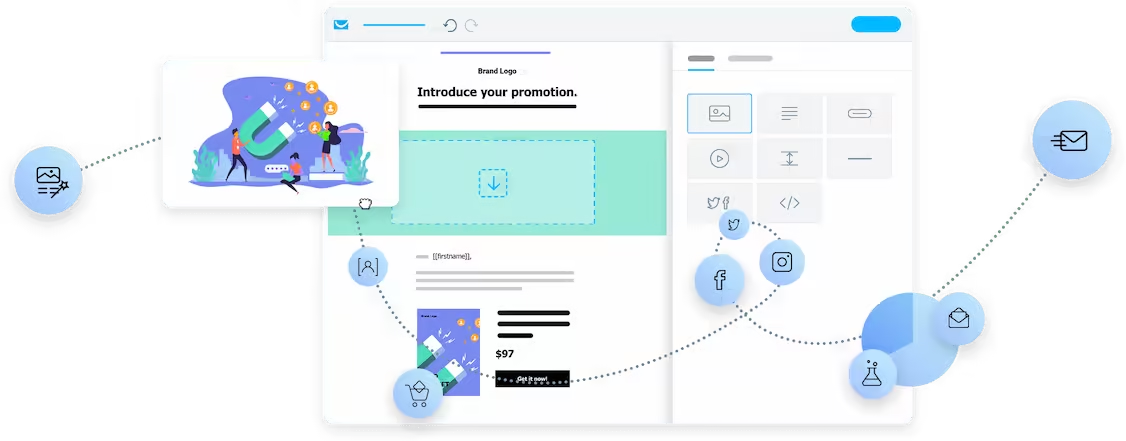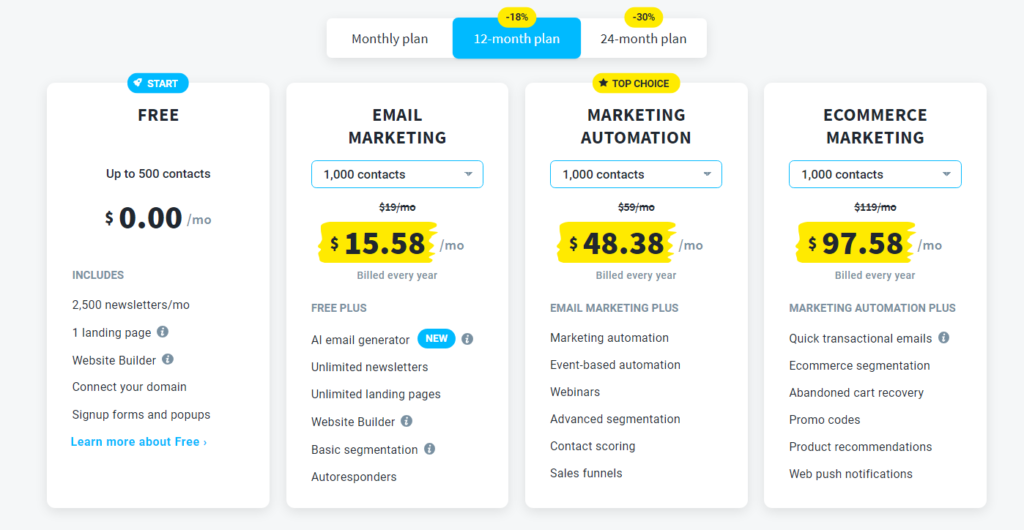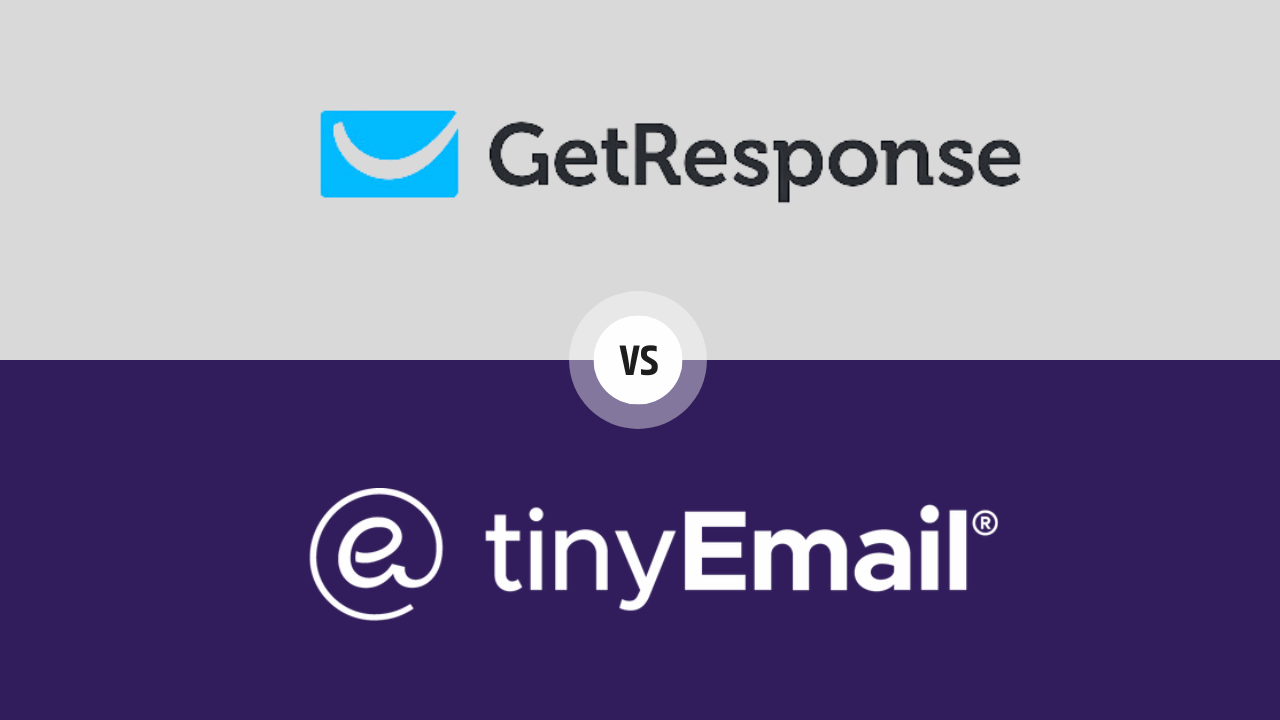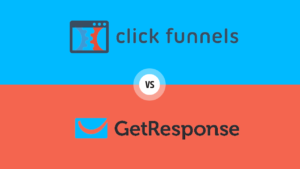In today’s digital landscape, two prominent contenders, GetResponse vs TinyEmail, stand out as formidable options. Email marketing is a cornerstone of modern digital marketing strategies, and choosing the right platform can make all the difference. Whether you’re a seasoned marketer looking for advanced automation or a startup seeking simplicity on a budget, this comparison will delve into the key aspects of both platforms to help you make an informed decision. Join us as we explore the world of GetResponse vs TinyEmail and find the perfect fit for your email marketing needs.
Table of Contents
Overview of GetResponse vs TinyEmail
When it comes to choosing the right email marketing platform, it’s crucial to understand the features, pricing, and overall capabilities of the options available. In this comparison, we’ll dive into the world of GetResponse vs TinyEmail to help you make an informed decision.
GetResponse User-Friendly Interface
GetResponse is a well-established player in the email marketing arena. Founded in 1997, it boasts a rich history of helping businesses of all sizes connect with their audiences through email campaigns. With over 350,000 customers worldwide, GetResponse has earned a reputation for its comprehensive set of features and user-friendly interface.

TinyEmail is an easy-to-use email marketing platform for small businesses and individuals.
TinyEmail, on the other hand, is a relatively newer contender in the email marketing space. It is an email marketing platform that makes it easy to create, send, and track email campaigns. It is designed for small businesses and individuals who want to get started with email marketing without the need for any coding knowledge. TinyEmail has gained popularity for its simplicity and affordability.
Pricing
Pricing is a critical factor when considering an email marketing platform. Let’s take a closer look at how GetResponse vs TinyEmail stack up in terms of their pricing structures.
GetResponse offers a tiered pricing model, designed to cater to businesses of all sizes. They provide four main pricing plans:

TinyEmail takes a simpler approach to pricing, which may appeal to smaller businesses or those on a tight budget. They offer two pricing plans:

Email Marketing Features
When it comes to email marketing, the features offered by GetResponse vs TinyEmail can significantly impact your campaign’s effectiveness. Let’s break down their key email marketing features:
GetResponse
- Drag-and-Drop Editor: GetResponse’s user-friendly editor simplifies email creation with drag-and-drop functionality.
- Automation: Create automated email sequences based on user actions and preferences.
- Personalization: Tailor emails with dynamic content for a personalized touch.
- A/B Testing: Test different email versions to optimize open and click-through rates.
- Responsive Templates: Access a library of mobile-responsive email templates.
- List Segmentation: Easily segment your subscribers for targeted campaigns.
- RSS to Email: Automate content sharing by converting blog updates into email newsletters.
TinyEmail
- Email Campaigns: Create and send email campaigns with ease.
- Basic Automation: Set up simple automation sequences for welcome emails and follow-ups.
- Templates: Access a selection of email templates for various purposes.
- List Management: Organize and maintain your email list efficiently.
- Analytics: Track key metrics like open rates and click-through rates.
Both platforms offer essential email marketing tools, but GetResponse provides a more extensive suite of features, including advanced automation and personalization options. Your choice depends on the complexity of your email marketing needs and your budget.
List Management
Automation and Workflow
Automation is a key element in effective email marketing, allowing you to streamline your campaigns and engage your audience efficiently. Let’s compare the automation and workflow capabilities of GetResponse vs TinyEmail:
GetResponse
- Advanced Automation: GetResponse offers a robust automation builder, allowing you to create complex workflows triggered by user actions.
- Behavioral Tracking: Track user behavior and send personalized emails based on their interactions.
- Webinar Automation: Seamlessly integrate webinars into your automated campaigns.
- E-commerce Automation: Automate product recommendations and cart abandonment emails for e-commerce businesses.
- Time-Based Triggers: Schedule emails to send at the perfect time for each subscriber.
TinyEmail
- Basic Automation: TinyEmail provides basic automation features suitable for simple email sequences.
- Workflow Simplicity: Automation workflows are straightforward, making them ideal for beginners.
- List-Based Automation: Trigger emails based on subscriber list membership and basic actions.
While TinyEmail offers automation suitable for simpler campaigns, GetResponse excels in advanced automation capabilities, making it the preferred choice for businesses requiring complex, behavior-triggered workflows.
A/B Testing
A/B testing is a vital tool for optimizing your email campaigns. Let’s compare how GetResponse vs TinyEmail handle A/B testing:
GetResponse
- Robust A/B Testing: GetResponse offers comprehensive A/B testing capabilities for various elements, including subject lines, content, and send times.
- Automated Winner Selection: It automatically selects the winning variant based on your chosen criteria, saving you time and effort.
- In-Depth Reporting: Access detailed reports to understand which elements drive better engagement.
- Advanced Options: Test up to five variants simultaneously for more in-depth optimization.
TinyEmail
- Basic A/B Testing: TinyEmail provides basic A/B testing for subject lines and content.
- Manual Winner Selection: You’ll need to manually select the winning variant based on your results.
- Simplified Reporting: Get basic insights into the performance of your A/B tests.
- Limited Variants: Test two variants at a time.
If A/B testing is a critical part of your email marketing strategy, GetResponse’s advanced features and automated winner selection can save you time and help you fine-tune your campaigns effectively.
Integration
Integration capabilities are crucial when choosing an email marketing platform. Let’s compare how GetResponse vs TinyEmail handle integrations:
GetResponse
- Extensive Integration: GetResponse offers seamless integration with a wide range of third-party tools and services, including popular CRMs, e-commerce platforms, and marketing software.
- API Access: Developers can utilize the GetResponse API for custom integrations.
- Webinar Integration: Integrate with webinar platforms for enhanced marketing campaigns.
TinyEmail
- Basic Integration: TinyEmail provides basic integration options, primarily focusing on common email marketing needs.
- Limited Third-Party Apps: While it covers essential integrations, it may have limitations when compared to GetResponse’s extensive options.
- Simplicity: Ideal for those seeking straightforward integrations without complexity.
Your choice between GetResponse and TinyEmail may depend on your specific integration requirements. If you need a broad array of integrations, GetResponse might be the better fit. However, if simplicity and basic integrations suffice, TinyEmail may meet your needs.
Analytics and Reporting
Effective email marketing relies on data-driven insights. Let’s compare the analytics and reporting features of GetResponse vs TinyEmail:
GetResponse
- Comprehensive Analytics: GetResponse provides detailed analytics on email open rates, click-through rates, conversion rates, and more.
- Conversion Funnel: Track the entire customer journey, from email opens to conversions.
- Automation Reports: Monitor the performance of your automated workflows.
- A/B Testing Insights: Analyze A/B test results to optimize campaigns.
- Visual Data: Graphical representations for quick data interpretation.
TinyEmail
- Basic Analytics: TinyEmail offers essential email metrics like open rates and click-through rates.
- Limited Insights: Reports may be more straightforward compared to GetResponse’s comprehensive analytics.
- User-Friendly: Ideal for users who prefer simplicity in data analysis.
When it comes to analytics and reporting, GetResponse stands out with its in-depth insights and visual representations. However, if you prefer a more straightforward approach, TinyEmail may be suitable for your needs.
Customer Support
Having reliable customer support is essential for a smooth email marketing experience. Let’s compare the customer support options of GetResponse vs TinyEmail:
GetResponse
- Diverse Support Channels: GetResponse offers various support channels, including email support, live chat, and phone support.
- 24/7 Availability: Their support team is available around the clock, ensuring assistance when you need it.
- Knowledge Base: Access a comprehensive knowledge base for self-help resources.
- Webinars and Tutorials: Learn through webinars and tutorials for in-depth guidance.
TinyEmail
- Email Support: TinyEmail primarily offers email support.
- Limited Support Hours: Support may not be available 24/7, which could impact response times.
- Basic Resources: They provide basic guides and FAQs for assistance.
For robust and round-the-clock support, GetResponse is the preferred choice. However, if you’re comfortable with email-based support and don’t require immediate assistance, TinyEmail may still meet your needs.
User Interface
Deliverability and Email Reputation
Customer Reviews and Testimonials
Listening to other people’s experiences is a great way to learn. Let’s see what customers have to say about GetResponse vs TinyEmail:
GetResponse
- Positive Reviews: Many users praise GetResponse for its user-friendly interface, automation features, and comprehensive email marketing capabilities.
- High Ratings: GetResponse consistently receives high ratings for its customer support and deliverability rates.
- Recommended by Businesses: Numerous businesses and marketers recommend GetResponse for its versatility.
TinyEmail
- Mixed Reviews: Reviews for TinyEmail vary, with some users appreciating its simplicity and affordability.
- Limited Testimonials: It may have fewer testimonials and reviews compared to GetResponse.
- Smaller User Base: TinyEmail may be preferred by startups and smaller businesses.
While GetResponse enjoys positive reviews and a larger user base, TinyEmail appeals to users seeking a straightforward and budget-friendly option. Reading user reviews can provide valuable insights into which platform aligns best with your specific needs.
Unique Selling Points
Each email marketing platform has its unique strengths. Let’s explore the standout features that set GetResponse vs TinyEmail apart:
GetResponse
- All-in-One Solution: GetResponse offers a comprehensive suite of marketing tools beyond email, including webinars, sales funnels, and landing pages.
- Advanced Automation: It excels in advanced automation features, making it suitable for complex marketing workflows.
- Conversion Funnel: GetResponse provides a built-in conversion funnel feature for seamless lead nurturing.
- Webinar Integration: Seamlessly host webinars within the platform.
TinyEmail
- Simplicity: TinyEmail’s simplicity appeals to users seeking a straightforward email marketing solution.
- Affordability: It offers budget-friendly pricing plans, making it accessible to startups and small businesses.
- Basic Automation: TinyEmail’s automation features cater to those with simpler automation needs.
- User-Friendly: Ideal for beginners and users who prefer a minimal learning curve.
Your choice between GetResponse and TinyEmail will depend on your specific needs. GetResponse shines with its all-in-one capabilities and advanced automation, while TinyEmail’s simplicity and affordability make it an attractive choice for those just starting with email marketing or seeking a budget-friendly solution.
Conclusion
Choosing between GetResponse and TinyEmail ultimately depends on your specific needs and priorities in email marketing:
- GetResponse: Ideal for businesses looking for an all-in-one solution with advanced automation, comprehensive features, and a versatile toolkit. It’s well-suited for those requiring complex workflows, webinars, and sales funnels.
- TinyEmail: A great choice for beginners, startups, and small businesses with simpler email marketing requirements. Its simplicity, affordability, and ease of use make it accessible to those on a budget.
Consider your business size, budget, and the complexity of your email marketing campaigns when making your decision. Both platforms have their strengths, so choose the one that aligns best with your goals and resources.
In this comparison of GetResponse vs TinyEmail, we’ve highlighted key aspects to help you make an informed choice. Whichever platform you choose, effective email marketing awaits to help you engage with your audience and achieve your marketing goals.
We hope this comparison has been valuable in guiding your decision-making process. If you have any further questions or need additional information, feel free to explore our other sections or reach out for more assistance.
Ready to dive even deeper? Explore our comprehensive comparisons of ‘ClickFunnels Vs GetResponse‘ alongside other top tools to make informed decisions that power your marketing success.



